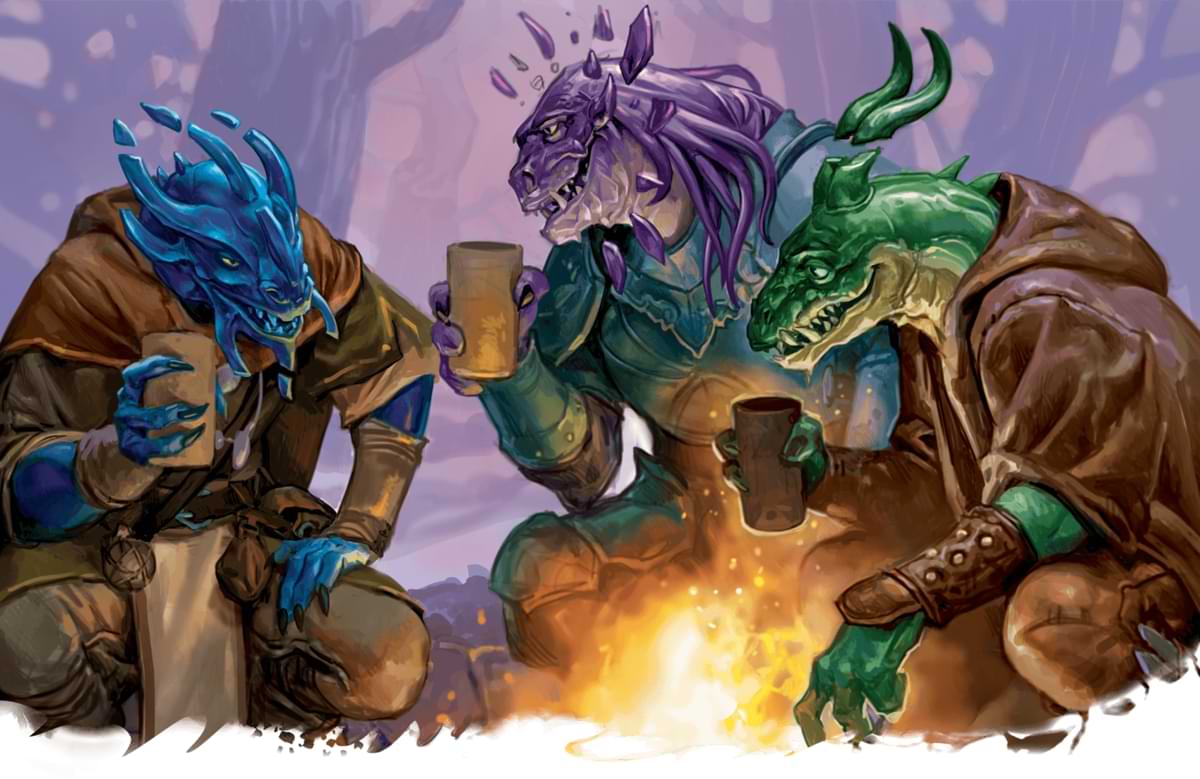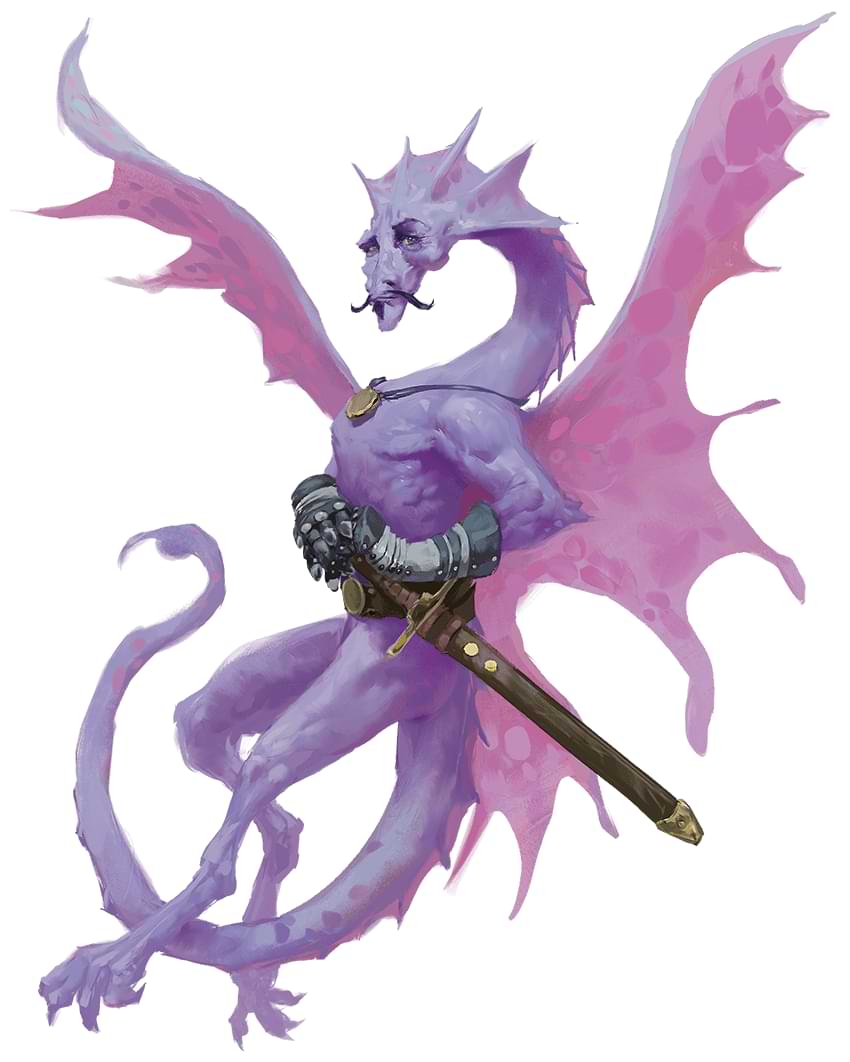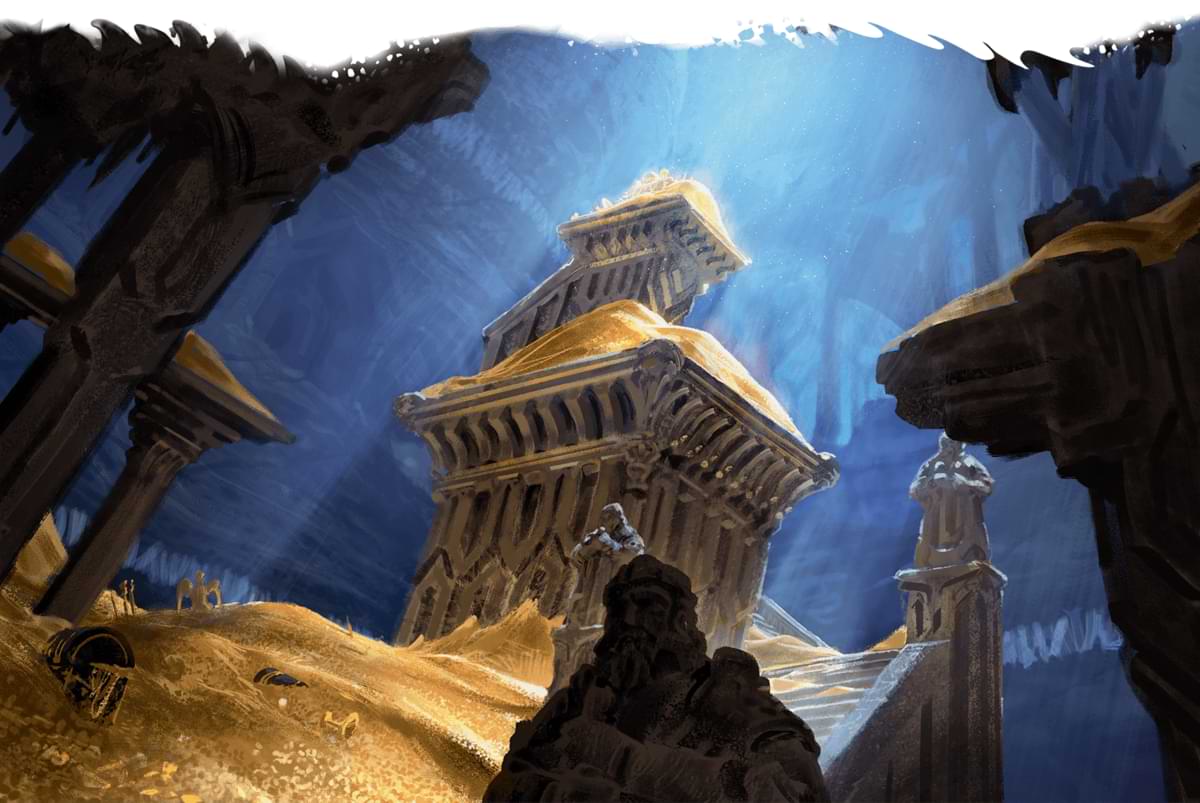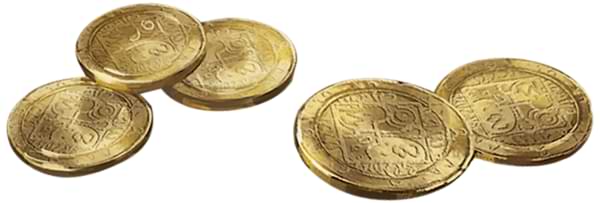Dragons are fearsome foes in the world of Dungeons & Dragons. But as with the characters that face off against them, their personalities, fears, and aspirations can vary wildly. So, there's bound to be a few quirky dragons out there. You don't need to be a standup comic to inject humor into your campaign, though. With a bit of basic improv and preparation, you can create memorable NPCs that entertain your players. Here's how:
- Follow this key improv rule
- Focus on one trait for countless laughs
- Play to the dragon's love of treasure
- Consider how they view others
- Lean into the social awkwardness
When to Use Comedy in D&D
When it comes to comedy, timing is key. You'll often want to wait until the party is out of danger before cracking jokes. A wisecrack made while monsters are murdering the characters can come off more mean than funny. Furthermore, jokes your group is likely to find offensive can do more harm than good. Use the same judgment you use when planning your adventures, and consider running a session zero to establish boundaries. Finally, laughs in a roleplaying game should ideally come from interacting with your players, and the easiest way to do this is through character-based improvisation.
1. Follow This Key Improv Rule

Improvisors create scenes from scratch using a method they call "Yes, and..." One actor makes a statement. Their scene partner agrees and adds another element. This interaction goes back and forth, building out the scene and the characters, like this:
Improviser 1: "The bus is late."
Improviser 2: "Yes, and now we won't make it to the museum on time. We should call in sick."
Improviser 1: "If I do that again, I'm fired. You have to lie for me."
You do this as a DM already. For example, a player might ask if there are any inscriptions on the walls of an ancient temple. Having given this zero thought, you say, "Yes, and you can make a rubbing with a DC 11 Dexterity check." Together, you've built a new layer of your world.
2. Focus on One Trait for Countless Laughs
 In conversation scenes, "Yes, and…" means having your NPCs acknowledge the characters' statements and respond with their own concerns on the subject. Any such character can be funny as long as they react to everything from the same point of view. This is how professional comedy writers do it.
In conversation scenes, "Yes, and…" means having your NPCs acknowledge the characters' statements and respond with their own concerns on the subject. Any such character can be funny as long as they react to everything from the same point of view. This is how professional comedy writers do it.
Examine any long-running sitcom, movie series, or animated property, and you will find characters who have generated thousands of jokes from one personality trait. They might be hot-tempered, rules-obsessed, or cowardly and have no other notable features. That one trait is all the writers need to make them funny in any situation because they understand that people love watching characters react to new things in predictable ways, whether in a comedy or a game of D&D.
The first comedic character in my campaign was created by accident. The party stopped some con men from swindling a dwarf named Johann, who I randomly gave a silly accent. The players laughed when he enthusiastically thanked them after saving him, so I had Johann bump into them again. All I knew about him was that he was a visitor to Greyhawk and thankful to the party, so I made him super excited to see them again, asking if they wanted to go out for drinks. They laughed again, so I brought him back whenever it was inconvenient. He was always enthusiastic and trying harder and harder to hang out.
If some of you read "accent" and got nervous, don't be. While giving comedic characters a distinctive, memorable voice is compelling, as cartoon producers have known since the first "talkies," it's unnecessary. If accents seem more trouble than they're worth, don't bother. Your laughs are meant to come from heightening a character's point of view, not the silliness of their speech. Moreover, many of the world's best improvisers, such as Eugene Levy, Ben Schwartz, and Dave Pasquesi, almost exclusively use their regular voices in performance.
Examples of Funny Character Traits
All you need to do is choose one trait for your character to heighten to absurdity. Since we are building funny dragons, we'll start with their first entry. The Monster Manual says some metallic dragons enjoy exploring civilization in humanoid form. However, there is nothing that says your metallic dragon bothered to pay attention to local customs or feels any need to mask their draconic behavior. What if they came to a royal dinner in human form but still acted like a dragon, eating pounds of dripping raw meat with their mouth and hands? At after-dinner drinks, they might gather a bunch of treasure on the floor, lie down on it, and talk casually the whole time like nothing is amiss.
The "Roleplaying Dragons" and "Draconomicon" sections of Fizban's Treasury of Dragons contains numerous traits to exaggerate into a comedic point of view. Consider these examples:
Blue Dragons
Blue dragons have humor listed as an ideal. Your blue dragon might have the cruel wit of a roast comic. To a dragonborn, they might say, "Nice face, mini-me. You forgot the being huge part." He could tear into anybody. "Hey human, got any more of those paintings where one of you kills one of us? Hilarious! Don't try it in real life. Hey elf, how does it feel to be annoying for centuries?"
Red Dragons
One red dragon ideal is greed. Perhaps your red dragon can't talk to anyone without coveting their possessions. "So, we were discussing those impudent ogres," they might say, and then, "Hold on. Is that a ring? Where'd you get that? I want that. Can I have that? Also, the sword. And the shoes and belt."
White Dragons
Even deadly serious ideals can be heightened into comedic traits. The white dragon has vengeance as an ideal. What if your white dragon wants revenge on everyone connected with his father's slaying but wants any retaliation to be proportional to their role in his death?
"There was a guy," they might say, "who fed the slayer's horse that day. It may not be worth death. How about a very costly home repair? And the stable keeper's next meal should be overwhelmingly disappointing!"
Gem Dragons and Other Chromatic Dragons
Some gem dragons and chromatic dragons have similar shades of color for their scales. Perhaps your emerald dragon hates being confused for the more popular green dragon and is sick of them. "Poison breath?" they might say. "All an enemy has to do is close their mouth. Try dodging pure psychic dissonance!"
Tying Dragons to the Characters
Some character creation options have built-in ties to dragons that could make for hilarious characters. For example, a Draconic Bloodline sorcerer's ancestor might want to connect and make up for lost time. They could give heartfelt gifts only useful for dragons, like 40 buffalo carcasses or a giant scratching post. The ancestor of a Drakewarden's drake could show up to make sure he's feeding him right, or the dragon founder of a monastery could show up to put it back on track from its current state of—in their opinion—disgrace.
3. Play to the Dragon's Love of Treasure
 Eccentricities are great for comedy, and an uncontrollable need to hoard treasure is a juicy one. Your dragon might try to justify it by saying, "If you were gold, wouldn't you rather hang out in this gorgeous vault with awesome stuff everywhere and a totally sweet dragon? Or end up in some tiny adventurer's grubby little sack and get spent on tinderboxes and rope?"
Eccentricities are great for comedy, and an uncontrollable need to hoard treasure is a juicy one. Your dragon might try to justify it by saying, "If you were gold, wouldn't you rather hang out in this gorgeous vault with awesome stuff everywhere and a totally sweet dragon? Or end up in some tiny adventurer's grubby little sack and get spent on tinderboxes and rope?"
The dragon might stare at other dragons' hoards all day on magical social media devices like enchanted mirrors and crystal balls, watching "unchesting" videos and wondering who should win "Best Goblet" at the Hoardies. They might gossip about certain dragons filling their lair with worthless knockoffs because they can't kill knights like they used to. They might conscientiously downsize their hoard because some treasures no longer spark joy. Good-aligned dragons might feel guilty about having a hoard, referring to it as "their personal collection" and opening it to the public as a museum on weekends. They might even give it all up to worship Bahamut in the mountains, leaving unforeseen violence in their wake as other monsters try to claim it for themselves.

Compulsively acquisitive dragons might behave like certain collectors in our world. "This is a 1266," a coin-obsessed dragon might say, "but you can see right here, the 'Minted in Thay' stamp is on the left, so it's actually a 1265 minted early with next year's date."
Some dragons may resent any expectations that they have a massive hoard of treasure. Such a dragon might end up wanting the characters to help them steal from another, more privileged dragon's hoard.
4. Consider How They View Others
Dragons might find lesser creatures so beneath them they aren't worth paying attention to. Because dragons can live for centuries, they may be unsure whether to speak to a grown adventurer as a child or adult. "Would you like a gold coin, little one?" they may ask. "G-O-L-D!"
They might be fascinated with anyone smaller than them, peppering them with eager questions like, "When you see a horse, are you just like, 'Wow, that's huge!'" and "What's the smallest thing that totally scares you? Is it a spider? You definitely look afraid of spiders."
A dragon's followers could even be a source of embarrassment. For example, your young black dragon might say, "About the ghouls. I know they're not awesome-looking draconians or whatever, but not a lot of cool monsters like to live in swamps—even though they rule."
5. Lean Into the Social Awkwardness
Even good-aligned dragons are still dragons, and the contradiction between their values and some of their behavior can make for funny traits. A brass dragon might eat his human allies' whole herd of cattle and then pay them back by dumping heavy treasures on their village from the sky.
A gold dragon might mean well but be comically out of touch, organizing a tone-deaf charity event for "the wingless," asking characters for testimonials about their awful flightless lives so her dragon friends may give generously.
Any piece of lore can be the spark you heighten into a hilarious recurring comical character to liven up encounters with faction contacts, group patrons, merchants, informants, and messengers. Add only as many as the tone of your campaign will support, and use them sparingly enough. You don't want to wear out their welcome. Once you know the secret, you can create a funny character for your players whenever you feel they could use a laugh.
Roll Your Charisma Check With Advantage
Any story is richer with comic relief. With these tips, even the most dangerous dragon can brighten the mood without having to light your party up with a breath weapon.
For more resources on leveling up your dragon game, check out Fizban's Treasury of Dragons. When you're ready to run an adventure chock-full of dragon goodness, Dragonlance: Shadow of the Dragon Queen is the book for you! Just a quick warning, though, the dragons in that book may be more inclined to ruthlessly murder the party than spend time wittily bantering.
Comedian and writer John Roy (@johnroycomic) has appeared on Conan and The Tonight Show and written for Vulture and Dragon Plus. He is the co-host of the comedy/war gaming podcast Legends of the Painty Men. His albums can be found on Apple Music and Spotify. He splits his time between Los Angeles and the Free City of Greyhawk.








-
View User Profile
-
Send Message
Posted Oct 6, 2022Great article. I absolutely love improving conversations, cuz you never know what’s gunna come from them. Who knows, maybe that blue dragon gets offended if you don’t talk about him in the 3rd person. Or maybe that gold dragon is tired of caring about people, and he doesn’t give a darn about about anything. The wackiest stuff comes from improve D&D. It’s the best. You’ll have a blast. Also, first
-
View User Profile
-
Send Message
Posted Oct 6, 2022My funny dragon is an ancient Moonstone dragon named Lonicera (the players told him that was the scientific name for honeysuckle, and he decided he was Honeysuckle from now on). He has absolutely no understanding of time, so he constantly uses the phrase "...in... well, I don't know how long."
-
View User Profile
-
Send Message
Posted Oct 6, 2022Ok, I kinda skimmed over this, but the gold dragon charity event really got me. Hilarious.
-
View User Profile
-
Send Message
Posted Oct 6, 2022This is great! I'm taking notes :D
-
View User Profile
-
Send Message
Posted Oct 6, 2022I love this! Keep up the dragon articles please! I'm planning a dragon themed campaign.
I had a lot of fun with an improvised dragon interaction recently.
The party was trying to bargain with a dragon for use of the magic spring the dragon had gotten tricked into guarding for eternity. The dragon agreed to allow the party to use the spring if they entertained her because she was super bored. These players had found a DND set in-game at level 2 after defeating some kobolds who were playing it. Their characters played DND with a dragon.
When they finished, they gave the dragon the DND set. As they left, they heard her playing with the figures and talking to herself.
Dragon: "I'm a stupid adventurer! I'm going to go poke a dragon! Oops, it ate me. I'm another stupid adventurer! I'm going to go poke a dragon..."
Character, to party: "I think I know how this is going to end."
Dragon "Oops, I fell off the cliff on the way there."
Character: "Oh, I guess not."
Dragons are the best.
-
View User Profile
-
Send Message
Posted Oct 6, 2022That is awesome.
-
View User Profile
-
Send Message
Posted Oct 6, 2022The buff dragon with the mustache is too much.
-
View User Profile
-
Send Message
Posted Oct 6, 2022A white dragon who will only eat gnomes because they know their kobolds don't like them, but has also slowly depleted the gnomish population for dozens of miles around over the years forcing them to go on long flights and adventures in search of gnomes to devour.
-
View User Profile
-
Send Message
Posted Oct 6, 2022Just a note on your "golden rule" of improv: You can't always say yes. "No, but" is also a valid improv option.
-
View User Profile
-
Send Message
Posted Oct 7, 2022A blue dragon who rules a city. The only laws in this city are the Dress Codes, which require everyone to wear blue.
-
View User Profile
-
Send Message
Posted Oct 7, 2022Lots of great ideas is this one. Thank you.
-
View User Profile
-
Send Message
Posted Oct 7, 2022How to make your dragons funny? Puns. Lots and lots of puns.
-
View User Profile
-
Send Message
Posted Oct 7, 2022According to the file name, that dragon is Sir Talavar.
-
View User Profile
-
Send Message
Posted Oct 8, 2022One of the best DDB articles I've seen in a while! I put incidental comedy into games all the time, but almost never with dragons. Thoughtful stuff. I'll be putting a chatty dragon in a game sometime soon. My taciturn dragon Hunter ranger will be taking "advantage", but still, bound to be hilarious for the survivor. :)
-
View User Profile
-
Send Message
Posted Oct 8, 2022While I am not usually a fan of funny D&D, this was great. The section about the good dragons paying for cattle eaten and holding a charity for the wingless is brilliant.
-
View User Profile
-
Send Message
Posted Oct 10, 2022Thank you
-
View User Profile
-
Send Message
Posted Oct 11, 2022Great article! I can't believe you didn't even mention copper dragons. Jokes are their thing!
-
View User Profile
-
Send Message
Posted Oct 11, 2022Fantastic Article. Dragons are very popular enemies within DND and I think it is very cool how comedy can make the characters so much deeper.
-
View User Profile
-
Send Message
Posted Oct 12, 2022Yeah, he's an npc from that recent feywild adventure book!
-
View User Profile
-
Send Message
Posted Oct 13, 2022Thank you. I sincerely appreciate the breakdown and relevant examples. Maybe now my players won't have to get me drunk so much.